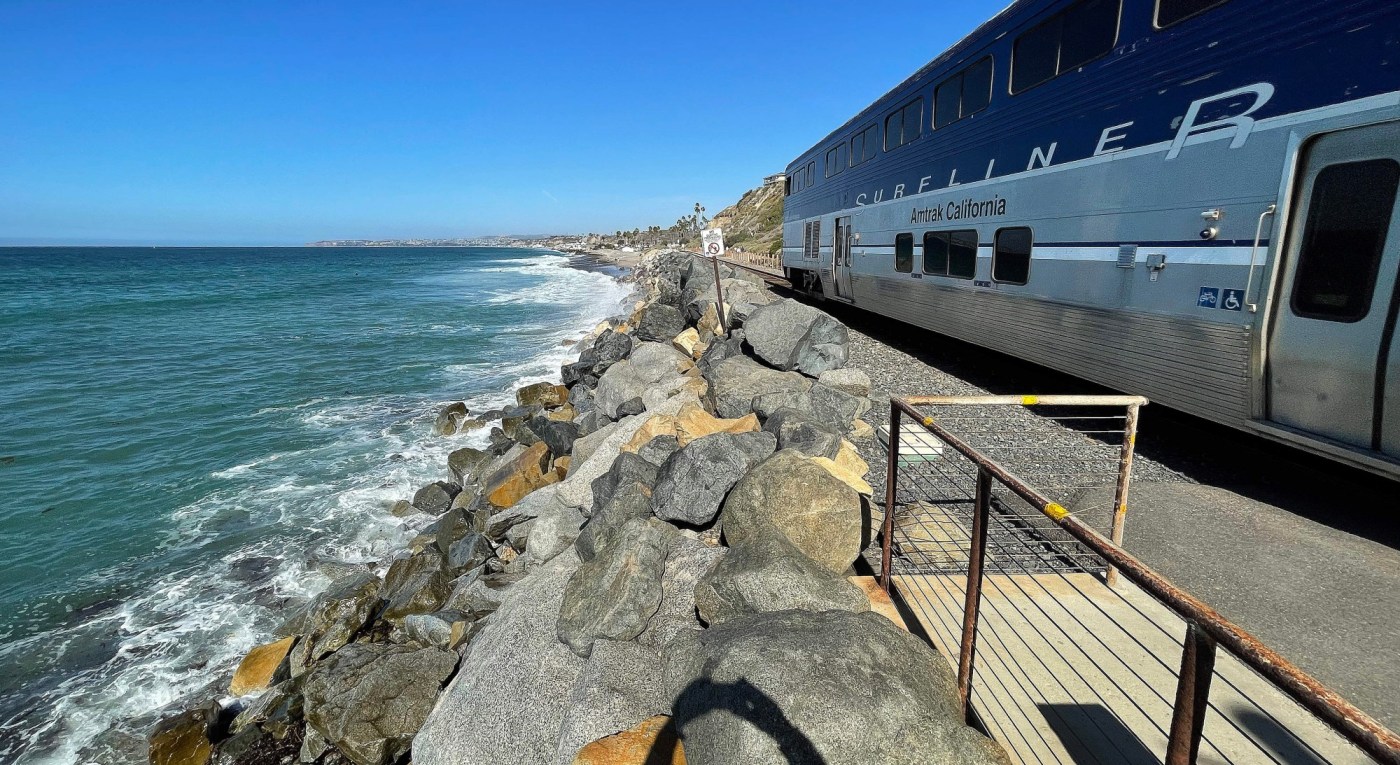The Orange County Transportation Authority has submitted an application to the California Coastal Commission for emergency work to stabilize a rail line that runs along the coast in San Clemente, at the same time requesting more information from companies that might be able to handle a sand replenishment project in the area.
The agency is proposing the $300 million plan to protect the Los Angeles-San Diego-San Luis Obispo, or LOSSAN, Corridor, which has been shuttered several times in recent years along the 7-mile coastal stretch by landslides and the ocean battering the tracks.
While an emergency permit would allow for the project to move along more quickly, opponents worry approval would skirt the typically required environmental reviews that would study impacts to the beach of placing more riprap and sand —reviews that would also give the public a say in the process, they argue.
The OCTA application was submitted Monday, March 31, and the agency also moved forward with a “request for information” for the sand portion of the project, which proposes to dredge or transport 540,000 cubic yards of sand to select stretches of the beach within the next 18 months, according to an OCTA announcement.
In addition to sand, plans include placing an estimated 42,750 tons of rock boulders on the beach along the rail line – the additional riprap is the most controversial part of the project because the hard armoring can have negative impacts on the sand space and lead to further erosion.

The project would also include installing retaining walls on the inland side of the rail line to protect the tracks from future landslides.
“For decades South County beaches eroded without adequate renourishment. This inaction caused widespread erosion, threatening our ocean economy, coastal rail corridor, and endangering our national defense and commerce,” Fifth District Supervisor Katrina Foley, who also sits on the OCTA board, said in a statement in support of the permit request.
The transportation authority has secured more than $300 million in federal and state funding for the stabilization project, which officials say would address four “hot spot areas” identified in 2023 “as most vulnerable to catastrophic failure from beach erosion, wave impacts, and slope failure.”
No date is set yet for when the California Coastal Commission will consider the permit request.
“I appreciate the California Coastal Commission’s consideration and willingness to work through an emergency permitting process, which includes the nature-based solution of sand renourishment instead of simply placing (rock) revetment,” Foley said.
Since 2021, emergency response to landslides and damage to this section of the 351-mile LOSSAN corridor has cost taxpayers more than $40 million to restore service, OCTA officials said. The response to track damage has been both in the form of placing boulders to build up revetments and the construction of containment walls.
A series of landslides near Mariposa Point have occurred over the past year and debris and mud are nearing the top of the 12-foot-tall temporary wall constructed in early 2024 when a slope failure forced rail service to shut down again for several months, OCTA officials said.
But Surfrider Senior California Policy Coordinator Mandy Sackett argues that previous emergency action by the OCTA has already had disastrous impacts on San Clemente’s beaches, especially along the southernmost section where a stretch of boulders were dumped following a track failure triggered by an ancient landslide and waves moving the tracks. She also raises concerns about potential impacts to San Clemente State Beach from the current proposal.
Instead of bringing in the hard armoring, the OCTA should focus its efforts on removing the track, she argues.
“It’s unacceptable that OCTA continues to default to hard armoring our public beaches without any clear plan to remove the riprap or protect the shoreline long term,” she said. “Every time they drop boulders on the sand, we lose more of San Clemente’s coast — permanently.
“Emergency permits are meant for actual emergencies, they are not a free pass to destroy our coast,” she added. “This decades-long problem should not be solved with an emergency permit, which undermines public participation. OCTA should conduct proper planning to find a long-term solution that does not destroy our beaches.”
At its April 14 meeting, the OCTA board of directors is expected to vote on action that would allow CEO Darrell Johnson to enter into emergency contracting agreements, including for the construction of a catchment wall along Mariposa Point that would include plans to restore San Clemente’s beach trail destroyed in the same landslide that shut down train service for weeks.

It would also allow him to enter into agreements to build a “revetment, seawall, or functionally equivalent” structure south of San Clemente State Beach.
An estimated 5,100 cubic yards of riprap would be put in front of the bridge at Mariposa Point, with an estimated 240,000 cubic yards of sand placed.
At the southern end of the project, near San Clemente State Beach, 1,400 cubic yards of riprap are proposed, along with 22,000 cubic yards of “engineered revetment, seawall or functionally equivalent structure” and 300,000 cubic yards of sand.
With a typical permitting process, total cost is estimated to be between $247 million to $340 million, but under an emergency permit the estimate would be between $210 million to $310 million, officials said.
If the emergency permit is approved, the construction would take 2.5 years, the agency estimates, versus more than three years under the regular permitting process.
